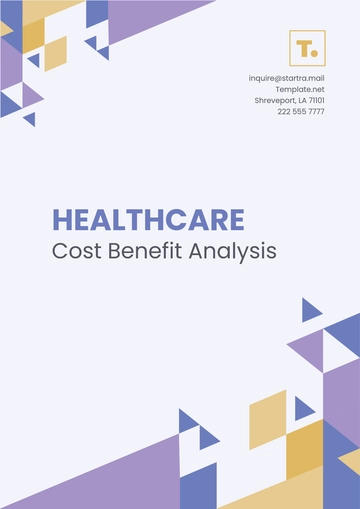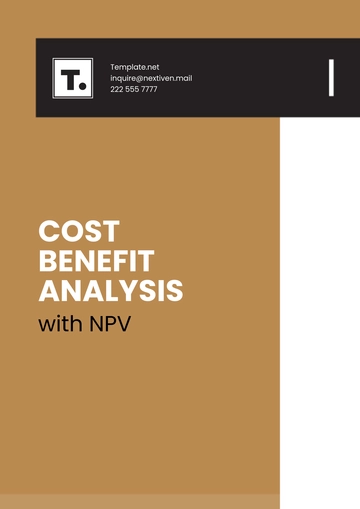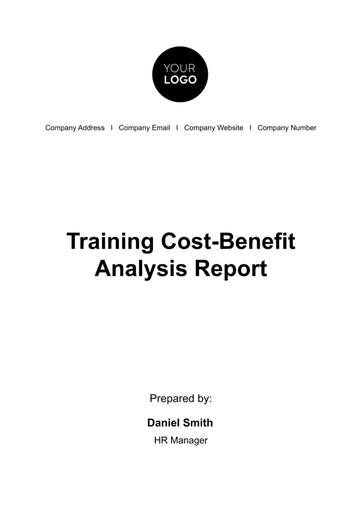Free Restaurant Cost Analysis Report

I. Executive Summary
The restaurant industry is a dynamic and competitive sector where effective cost management is crucial for success. This report presents a comprehensive analysis of the cost structure of [Your Company Name]'s restaurant operations. Our objective is to dissect the various cost components, identify potential areas for cost reduction, and suggest measures for efficiency improvement.
Our analysis focuses on several key areas that significantly impact the restaurant’s operational costs. These areas include labor costs, food and beverage costs, overhead expenses, and utility expenditures. By thoroughly examining each component, we aim to gain a deeper understanding of the cost drivers and devise effective cost control strategies.
The findings and recommendations in this report are intended to support strategic decision-making and optimize financial performance. By addressing these key cost components, we can develop strategies to optimize cost management and improve profitability. This will enable [Your Company Name] to maintain a competitive edge in the restaurant industry and achieve sustainable growth.
II. Cost Breakdown
A. Labor Costs
Labor costs are a critical component of a restaurant’s total expenses. This section provides an in-depth analysis of wages, benefits, and other labor-related expenses. The following table offers a detailed breakdown of labor costs for the last quarter:
Category | Amount | Percentage of Total Cost |
|---|---|---|
Wages | $50,000 | 69.44% |
Benefits | $15,000 | 20.83% |
Overtime | $5,000 | 6.94% |
Training | $2,000 | 2.78% |
Total | $72,000 | 100% |
Our analysis reveals that wages form the largest portion of labor costs, accounting for approximately 69.44% of the total. This suggests that wage expenses are a significant cost driver in our operations. It is important to ensure that wage levels are competitive to attract and retain quality staff, but also balanced with the financial health of the restaurant.
Benefits, representing 20.83% of labor costs, are another important factor. They play a crucial role in employee satisfaction and retention. It may be beneficial to review the current benefits package and consider if there are more cost-effective options that still provide value to employees.
Overtime costs, although smaller in comparison, should not be overlooked. At approximately 6.94% of total labor costs, minimizing overtime can lead to noticeable cost savings. This could be achieved through efficient scheduling and ensuring adequate staffing levels to handle peak times.
Training costs account for the smallest portion at approximately 2.78%. However, investing in employee training can lead to increased productivity and efficiency, thereby potentially reducing other labor costs in the long run.
Overall, labor costs represent a significant portion of the restaurant’s expenses. By understanding the breakdown of these costs, we can identify areas for potential savings and efficiency improvements. For instance, optimizing scheduling to reduce overtime, reviewing benefits packages for cost-effectiveness, and investing in training to boost productivity. These approaches can assist [Your Company Name] in effectively controlling labor expenses, thereby enhancing the restaurant's profitability and financial outcomes.
B. Food and Beverage Costs
Food and beverage costs are a critical component of a restaurant’s operational expenses. They encompass various elements such as the cost of ingredients, beverages, condiments, and packaging. The following table provides a detailed breakdown of food and beverage costs for the last quarter:
Category | Amount | Percentage of Total Cost |
|---|---|---|
Ingredients | $35,000 | 66% |
Beverages | $10,000 | 19% |
Condiments | $5,000 | 9% |
Packaging | $3,000 | 6% |
Total | $53,000 | 100% |
Our analysis reveals that ingredients form the largest portion of food and beverage costs, accounting for 66% of the total. This suggests that ingredient expenses are a significant cost driver in our operations. It is important to ensure that the quality of ingredients is balanced with the financial health of the restaurant.
Beverages, representing 19% of food and beverage costs, are another important factor. They play a crucial role in customer satisfaction and restaurant profitability. It may be beneficial to review the current beverage offerings and consider if there are more cost-effective options that still provide value to customers.
Condiments and packaging costs, although smaller in comparison, should not be overlooked. At 9% and 6% of total food and beverage costs respectively, minimizing these costs can lead to noticeable cost savings. This could be achieved through efficient sourcing and usage of condiments and packaging materials.
Overall, food and beverage costs represent a significant portion of the restaurant’s expenses. By understanding the breakdown of these costs, we can identify areas for potential savings and efficiency improvements. For example, improving the procurement and utilization of ingredients, evaluating drink options for economic efficiency, and effective acquisition and consumption of condiments and packaging supplies. These ways can assist [Your Company Name] in efficiently controlling food and beverage expenses, thereby enhancing the restaurant's profitability and overall financial results.
III. Overhead Expenses
Overhead expenses are a significant component of a restaurant’s operational costs. They encompass a wide range of expenditures that are necessary for the day-to-day operation of the restaurant. The following table provides a detailed breakdown of overhead expenses for the last quarter:
Category | Amount | Percentage of Total Cost |
|---|---|---|
Rent | $20,000 | 51% |
Marketing | $8,000 | 21% |
Insurance | $6,000 | 15% |
Administrative | $5,000 | 13% |
Total | $39,000 | 100% |
A. Rent
Rent forms the largest portion of overhead costs, accounting for 51% of the total. This suggests that rent expenses are a significant cost driver in our operations. It is important to ensure that the location of the restaurant is balanced with the financial health of the restaurant. The location of a restaurant can significantly impact its success, but high rent costs can strain the restaurant’s budget. Therefore, it’s crucial to find a balance between a prime location and affordable rent.
B. Marketing
Marketing, representing 21% of overhead costs, is another important factor. It plays a crucial role in attracting customers and driving restaurant sales. It may be beneficial to review the current marketing strategies and consider if there are more cost-effective options that still provide value to the restaurant. Effective marketing can increase a restaurant’s visibility and attract more customers, but it’s important to ensure that the cost of marketing campaigns doesn’t outweigh their benefits.
C. Insurance
Insurance, although smaller in comparison, should not be overlooked. At 15% of total overhead costs, minimizing these costs can lead to noticeable cost savings. This could be achieved through efficient sourcing and usage of insurance resources. Insurance is a necessary expense to protect the restaurant from potential risks, but it’s important to ensure that the restaurant is not over-insured.
D. Administrative
Administrative costs are essential for the smooth operation of the restaurant, but these should be regularly reviewed to identify any areas of inefficiency. At 13% of total overhead costs, efficient management of these resources can lead to cost savings.
Overhead costs represent a significant portion of the restaurant’s expenses. By understanding the breakdown of these costs, we can identify areas for potential savings and efficiency improvements. For example, by examining ways to decrease rent costs, evaluating marketing tactics to ensure they are economically viable, and optimizing insurance and administrative operations, [Your Company Name] can control overhead expenses better, thereby enhancing the restaurant's profitability and overall financial health.
IV. Utility Expenditures
Utility expenditures are a crucial part of a restaurant’s operational costs. They include essential services such as electricity, water, and gas. The following table provides a detailed breakdown of utility costs for the last quarter:
Category | Amount | Percentage of Total Cost |
|---|---|---|
Electricity | $7,000 | 58% |
Water | $3,000 | 25% |
Gas | $2,000 | 17% |
Total | $12,000 | 100% |
A. Electricity
Electricity forms the largest portion of utility costs, accounting for 58% of the total. This suggests that electricity expenses are a significant cost driver in our operations. It is important to ensure that the usage of electricity is balanced with the financial health of the restaurant. The usage of electricity can significantly impact the restaurant’s operations, but high electricity costs can strain the restaurant’s budget. Therefore, it’s crucial to find a balance between efficient use of electricity and affordable costs.
B. Water
Water, representing 25% of utility costs, is another important factor. It plays a crucial role in the restaurant’s operations. It may be beneficial to review the current water usage and consider if there are more cost-effective options that still provide value to the restaurant. Effective water management can reduce a restaurant’s utility costs, but it’s important to ensure that the cost of water doesn’t outweigh its benefits.
C. Gas
Gas, although smaller in comparison, should not be overlooked. At 17% of total utility costs, minimizing these costs can lead to noticeable cost savings. This could be achieved through efficient sourcing and usage of gas resources. Gas is a necessary expense for the restaurant’s operations, but it’s important to ensure that the restaurant is not overusing gas.
In summary, utility costs represent a significant portion of the restaurant’s expenses. By understanding the breakdown of these costs, we can identify areas for potential savings and efficiency improvements. For instance, exploring options for reducing electricity and water usage, and efficient sourcing and usage of gas resources. These strategies can help [Your Company Name] manage utility costs effectively, ultimately improving the bottom line and financial performance of the restaurant.
V. Recommendations
Based on our cost analysis, we propose the following actionable recommendations to optimize cost management and improve profitability for [Your Company Name]:
A. Labor Cost Management
Optimize labor scheduling: Efficient scheduling can significantly reduce overtime costs. By ensuring adequate staffing levels during peak times, we can minimize the need for employees to work beyond their scheduled hours. This not only reduces labor costs but also prevents employee burnout, thereby improving staff productivity and morale.
Invest in employee training: While training incurs costs, it is an investment that can lead to increased productivity and efficiency. Well-trained employees are more competent and efficient, reducing the likelihood of costly mistakes and improving service quality. Regular training programs can also boost employee morale and job satisfaction, leading to lower turnover rates.
B. Food and Beverage Cost Control
Conduct regular inventory audits: Regular inventory checks can help track usage and prevent overstocking or understocking. This can reduce waste and ensure that the restaurant always has sufficient supplies to meet customer demand.
Negotiate better terms with suppliers: Building strong relationships with suppliers can open up opportunities for negotiation. By negotiating better terms, the restaurant can achieve cost savings without compromising on the quality of food and beverages.
Implement portion control standards: Portion control can reduce waste and ensure consistency in the food served. This not only helps control food costs but also ensures that customers always receive the same portion size, improving customer satisfaction.
C. Overhead Cost Reduction
Explore options for reducing rent expenses: If the current location’s rent is straining the budget, it may be worth exploring other locations. Moving to a more affordable location or negotiating better lease terms can result in significant cost savings.
Review marketing strategies for cost-effectiveness: Marketing is essential for attracting customers, but it’s important to ensure that the benefits outweigh the costs. Reviewing current marketing strategies and exploring more cost-effective methods can help optimize marketing spend.
Efficient sourcing and usage of insurance and administrative resources: Regularly reviewing insurance coverage can ensure that the restaurant is adequately protected without being over-insured. Similarly, streamlining administrative processes can reduce administrative costs.
D. Utility Cost Management
Invest in energy-efficient appliances: Energy-efficient appliances can significantly reduce electricity costs. While the upfront cost may be higher, the long-term savings can be substantial. Additionally, energy-efficient appliances are often more durable and require less maintenance, leading to further cost savings.
Implement water-saving measures: Simple measures such as fixing leaks promptly, installing low-flow faucets, and reusing water where possible can lead to significant water savings. This not only reduces water costs but also contributes to environmental sustainability.
Conduct regular maintenance checks: Regular maintenance checks can prevent costly repairs and downtime. By identifying and addressing issues early, we can ensure that all equipment and facilities are running efficiently and avoid unexpected repair costs.
VI. Conclusion
In conclusion, this Cost Analysis Report provides a comprehensive examination of the key cost components affecting [Your Company Name]'s restaurant operations. By addressing labor costs, food and beverage expenses, overhead, and utility costs, we have developed strategies to optimize cost management and improve profitability. The insights derived from this report are intended to support strategic decision-making, optimize financial performance, and enhance the overall efficiency of [Your Company Name].
We believe that the recommendations outlined in this report will support [Your Company Name] in achieving its financial goals and maintaining sustainable growth in the highly competitive restaurant industry. Continued monitoring and evaluation of cost structures will be essential to ensure ongoing success and operational excellence. This report serves as a roadmap for [Your Company Name] to navigate the complexities of cost management in the restaurant industry, and we hope that it will be instrumental in driving [Your Company Name]'s financial success.
- 100% Customizable, free editor
- Access 1 Million+ Templates, photo’s & graphics
- Download or share as a template
- Click and replace photos, graphics, text, backgrounds
- Resize, crop, AI write & more
- Access advanced editor
Optimize your cost management with the Restaurant Cost Analysis Report Template from Template.net! This editable template allows for detailed cost analysis tailored to your needs. Customize the report to suit your restaurant’s financial structure using the customizable features. Use the AI Editor Tool to ensure a professional and accurate analysis!





























